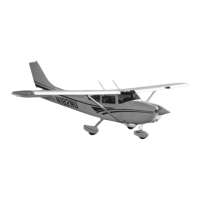SECTION 7 CESSNA
AIRPLANE AND SYSTEM DESCRIPTION MODEL T182T NAV III
GFC 700 AFCS
U.S.
AVIONICS SUPPORT EQUIPMENT (Continued)
ANTENNAS
Two combination VHF COM/GPS antennas are mounted on the top of
the cabin. The dual-mode COM 1/GPS 1 antenna is mounted on the
right side. Earlier production airplanes are configured with a tri-mode
COM 2/GPS 2/XM antenna mounted on the left side, while later
production airplanes are configured with a dual-mode COM 2/GPS 2
antenna mounted on the left side and a separate XM antenna mounted
on top of the cabin. The combination VHF COM/GPS antennas are
connected to the two VHF communication transceivers, the two GPS
receivers in the integrated avionics units, and the GDL.
A blade-type navigation antenna is mounted on either side of the
vertical stabilizer. This antenna provides VOR and glideslope signals to
the VHF navigation receivers contained in the integrated avionics units.
The marker beacon antenna is mounted on the bottom of the tailcone.
It provides the signal to the marker beacon receiver located in the audio
panel.
The transponder antenna is mounted on the bottom of the cabin and is
connected to the Mode S transponder by a coaxial transmission cable.
The L3 Communications WX-500 Stormscope antenna is mounted on
the bottom of the tailcone and is connected to the L3 Communications
WX-500 Stormscope receiver by an antenna cable assembly.
The Bendix/King Distance Measuring Equipment (DME) antenna (if
installed) is mounted on the bottom of the tailcone and is connected to
the Bendix/King DME receiver by a coaxial cable.
The Bendix/King Traffic Advisory System (TAS) (if installed) has two
antennas. A directional antenna is mounted on top of the cabin forward
of the COM antennas and an omni-directional antenna is mounted on
the bottom of the tailcone. Both antennas are connected to the Bendix/
King TAS receiver by coaxial cables.
(Continued Next Page)
T182TPHBUS-01
7-90

